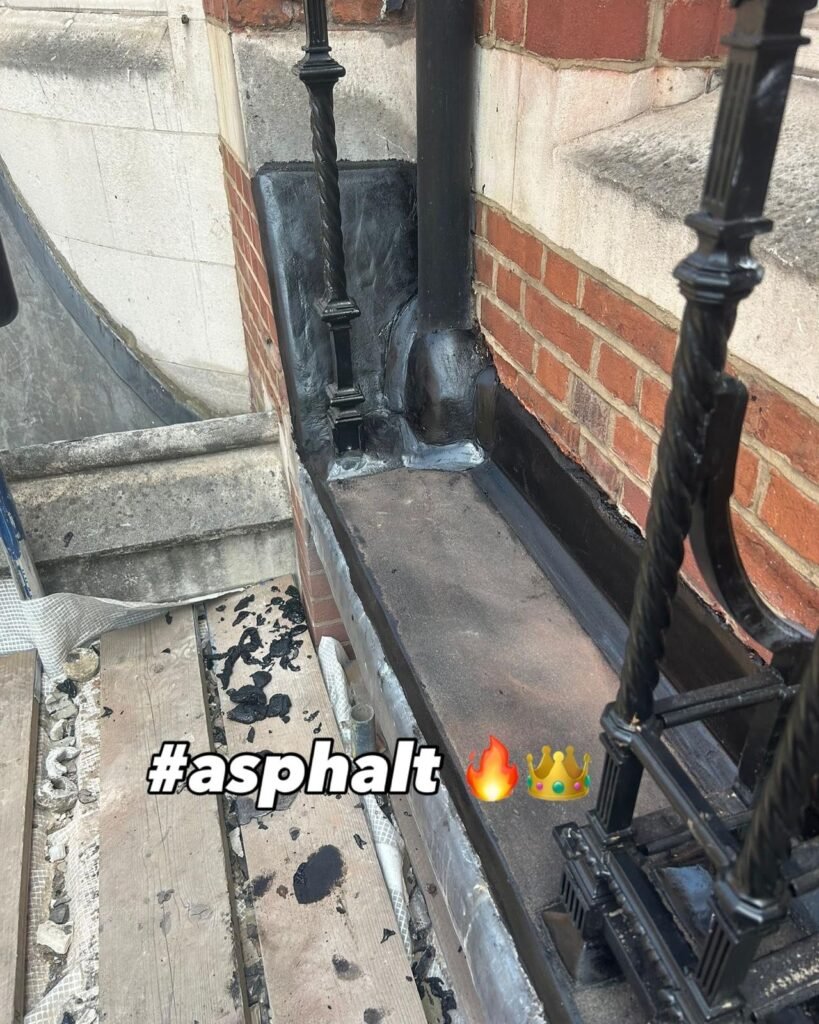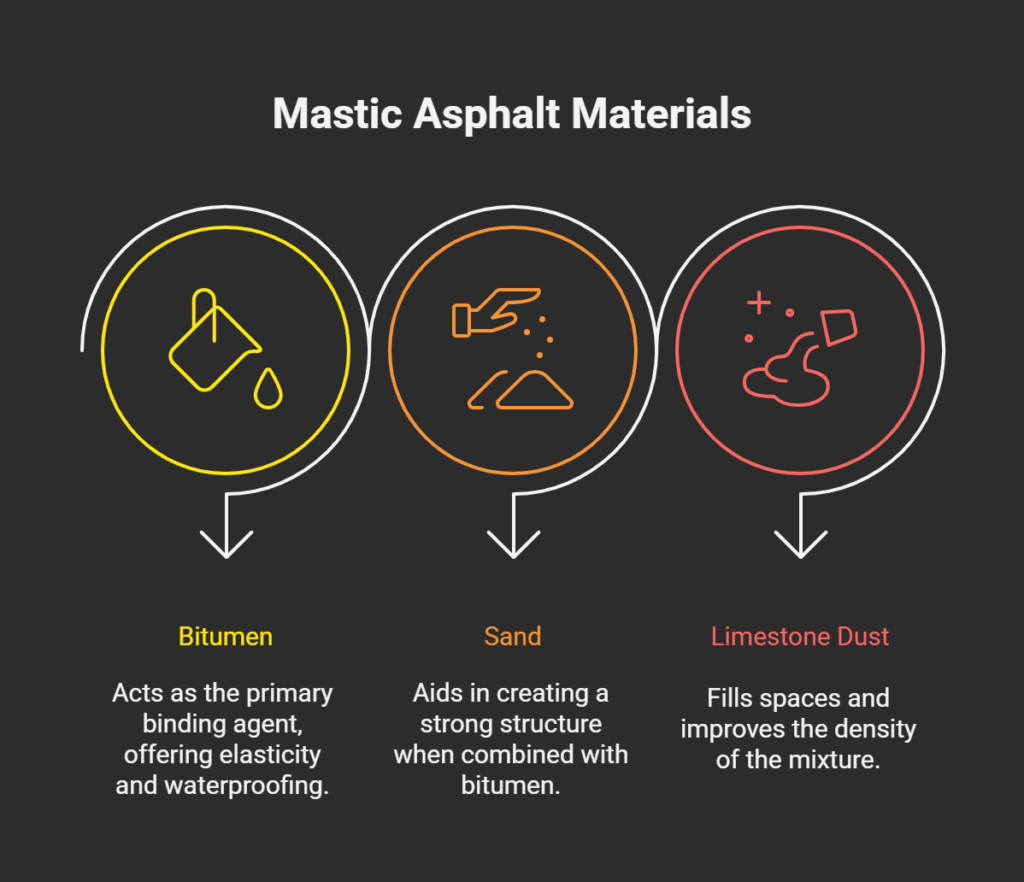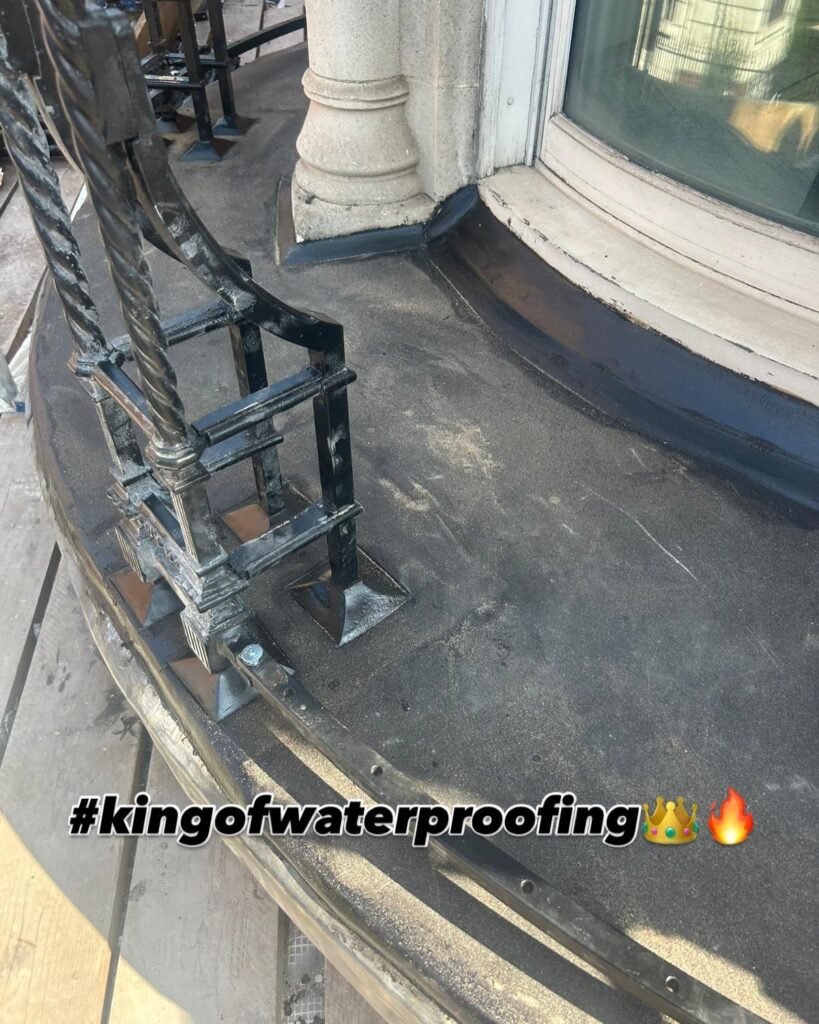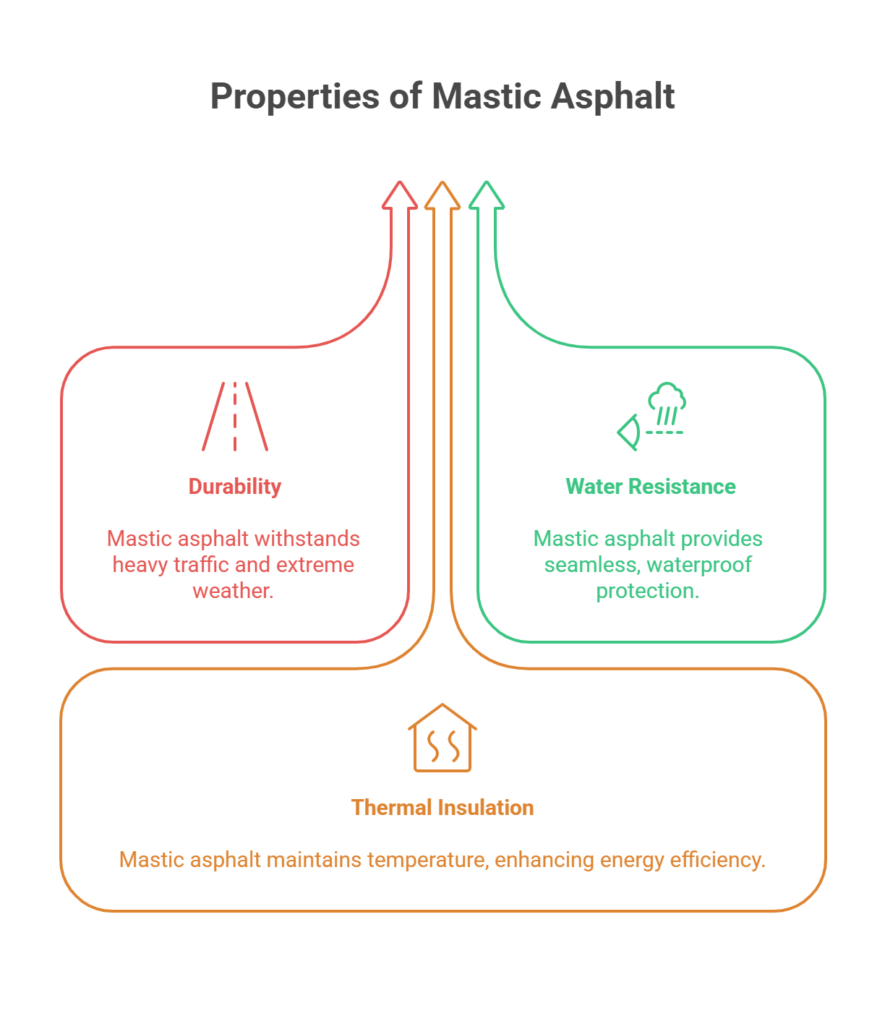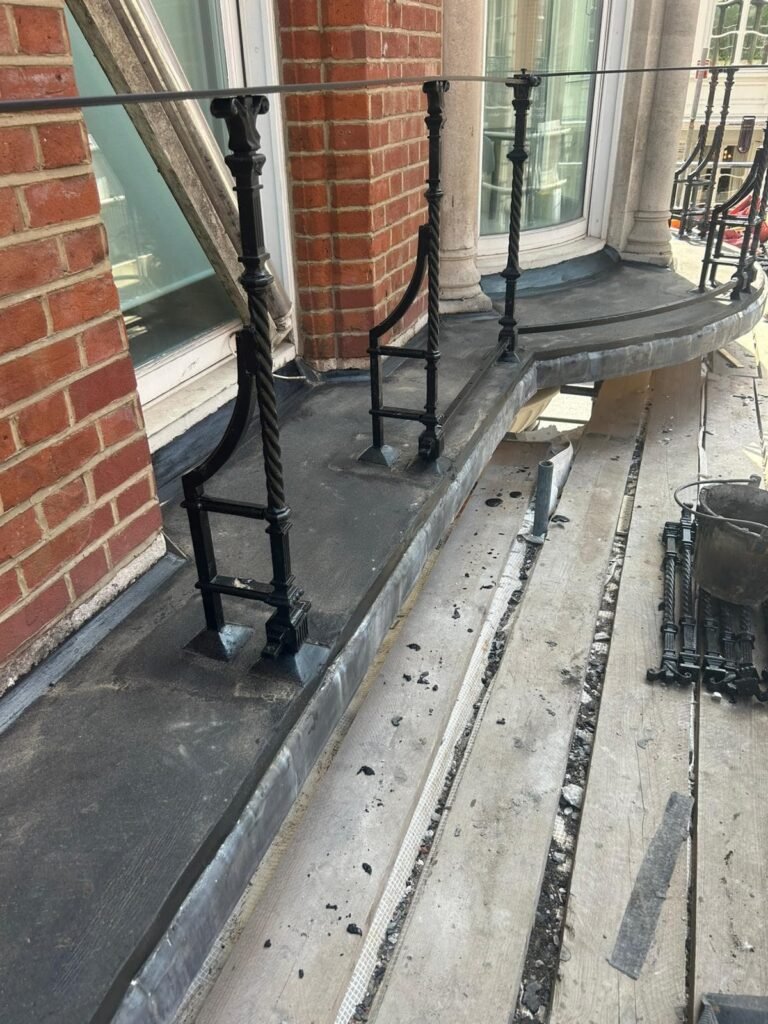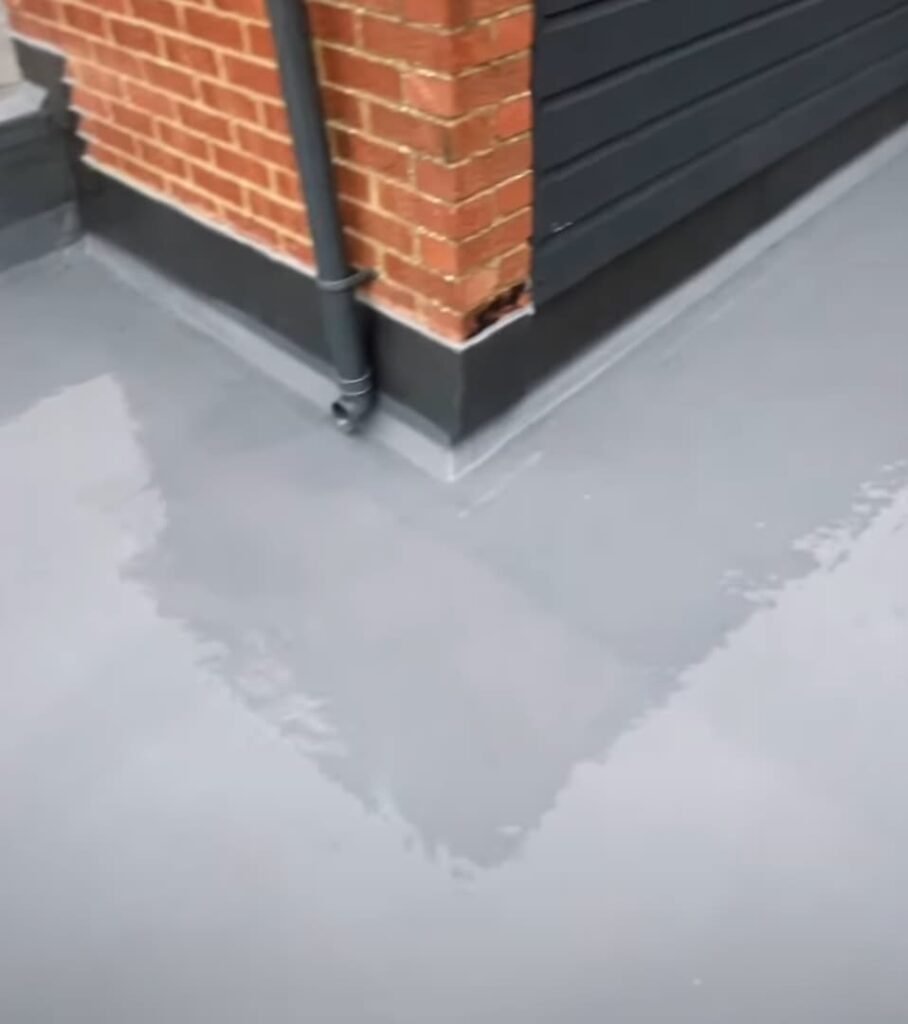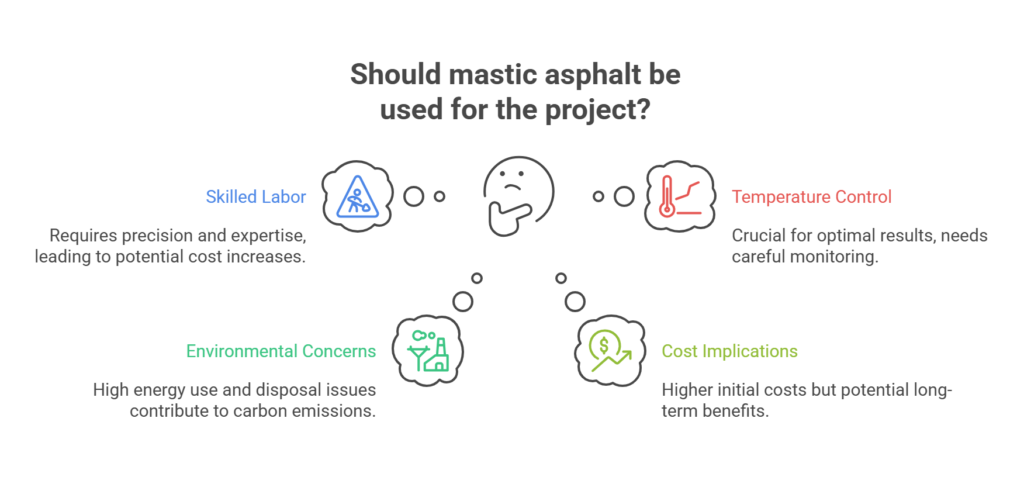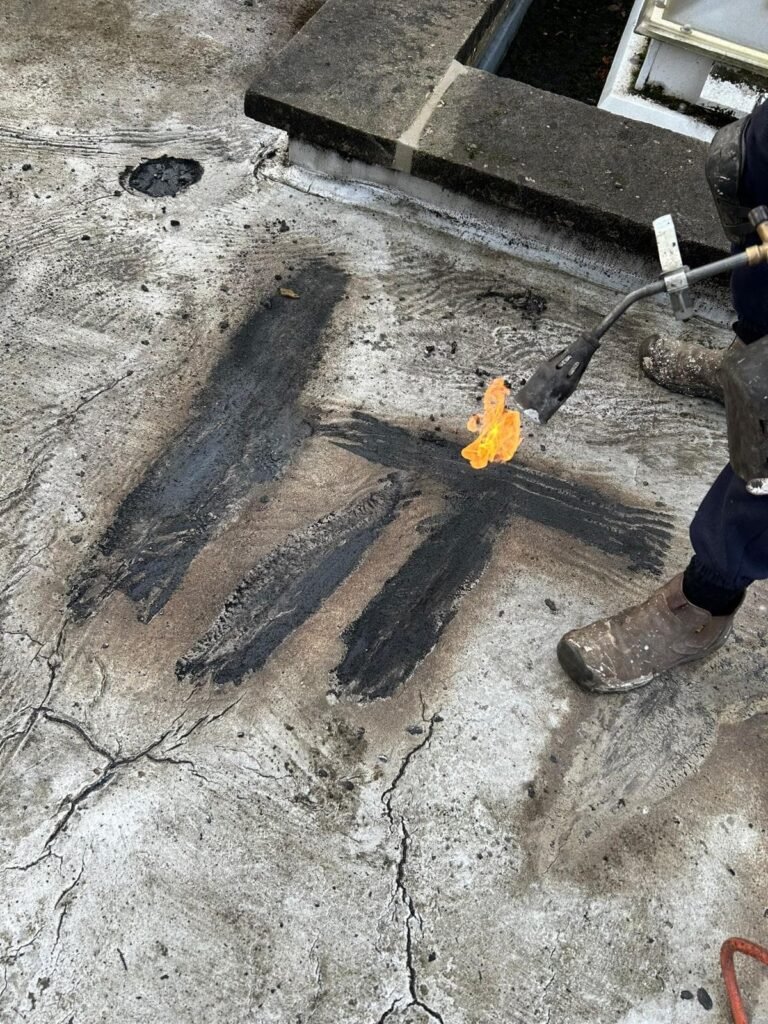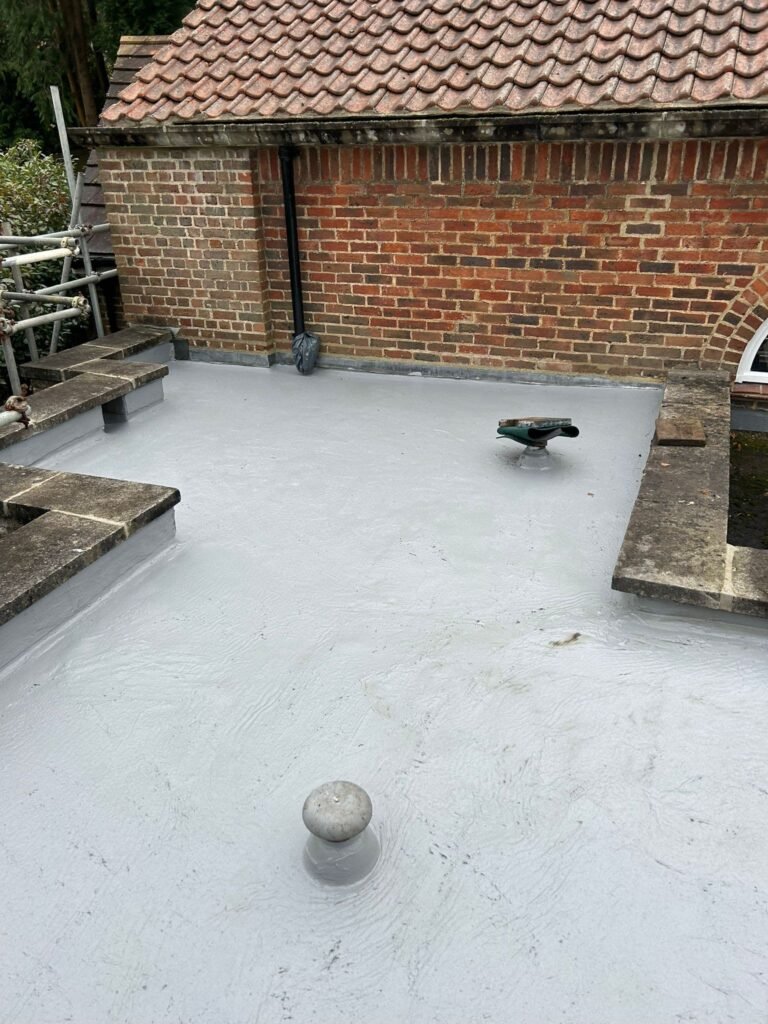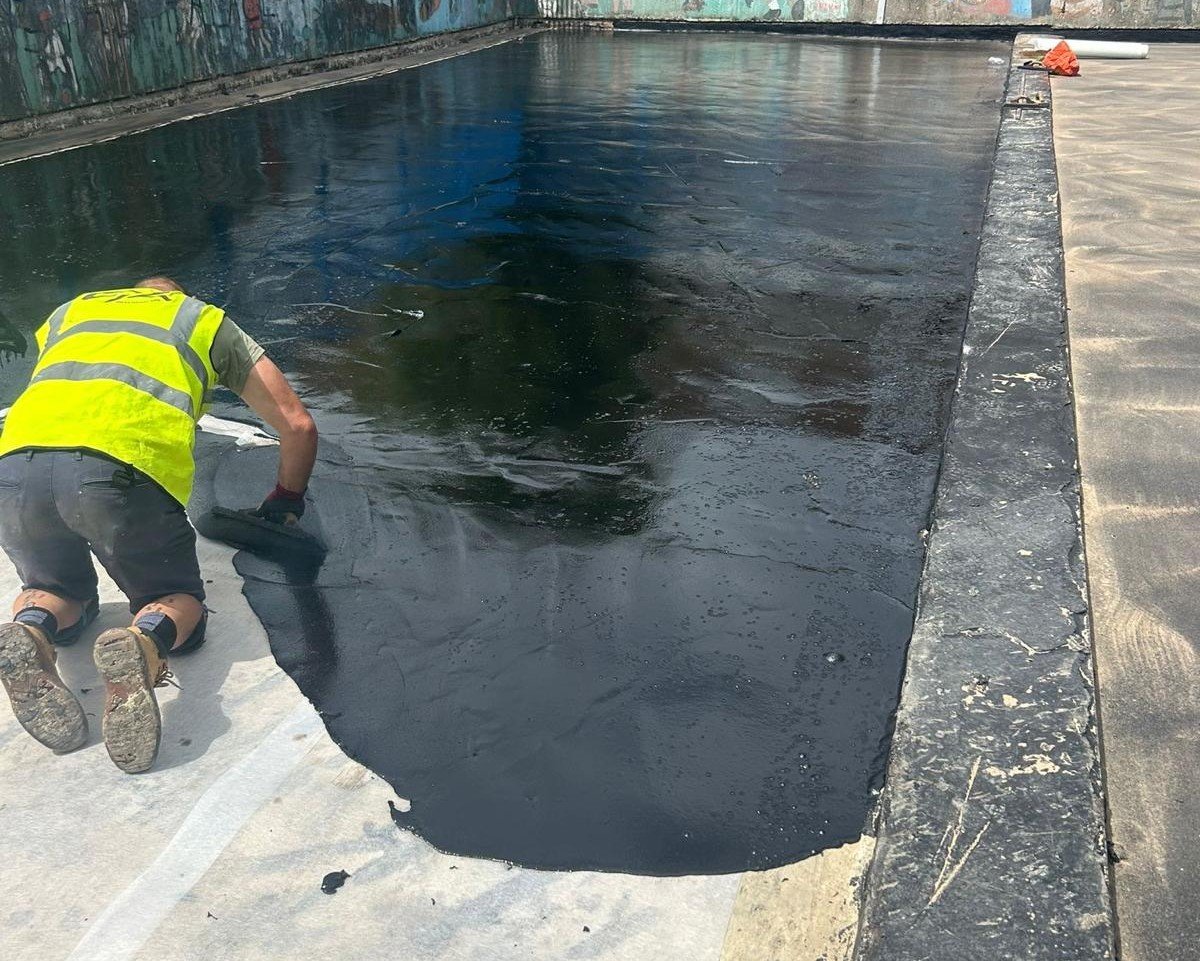
Contents
Our Services
Liquid waterproofing
What Client Say
I would just like to say a big thank you to the Denco team for the work they recently did on our roof, such a great finish. They repaired the old asphalt and covered it with a lovely new grey liquid coating. Leaving the premises very clean and tidy, we are so pleased with the end result. Thank you again guys.
Thank you to Lee and his colleagues from Denco Waterproofing for the outstanding job that they have completed on our balcony. Very impressed with there standard of workmanship and will definitely be having them back to replace the flat roof on our extension soon.
Great work by the Denco Waterproofing lads, very hard working, extremely tidy and the attention to detail was top class. Well done job all round. Many thanks.
Need help?
Don't hesitate to contact us
Send a message
Imagine a world where your driveway or roof never cracks, leaks, or wears out. Sounds too good to be true, right?
Well, that’s exactly what mastic asphalt promises. But how does it work its magic? Curious about how this ordinary material offers strong durability and protection? You’re in the right place. We’ll reveal why mastic asphalt works so well. It could be the answer you need.
Get ready to discover a material that could save you time, money, and endless headaches. Let’s dive in and explore how mastic asphalt works wonders for your surfaces.
What Is Mastic Asphalt?
Mastic asphalt is a versatile building material used in various construction projects. It offers a durable and waterproof solution for roofs, roads, and floors. But what exactly is mastic asphalt? This section will explore its composition. We’ll also see why it’s a top choice for construction.
Mastic asphalt is a type of asphalt that is dense and highly impermeable. It is made by heating asphalt and mixing it with a fine aggregate. This mix creates a smooth, durable, and waterproof layer when applied.
The main components of mastic asphalt include:
- Bitumen: A sticky, black, and viscous liquid or semi-solid form of petroleum.
- Fine Aggregate: Usually limestone, which provides strength and stability.
- Filler: Often limestone dust, which enhances the mix’s binding quality.
This combination gives mastic asphalt its unique properties. It can be spread in a molten form and hardens quickly, providing a seamless finish.
Mastic asphalt is known for several key properties:
| Property | Details |
| Durability | Can last up to 50 years with minimal maintenance. |
| Waterproofing | Provides excellent protection against water ingress. |
| Flexibility | Adapts to structural movements without cracking. |
These properties make mastic asphalt suitable for many applications. From roofing to flooring, its benefits are clear.
Applications Of Mastic Asphalt
Mastic asphalt is used in a variety of construction projects:
- Roofing: Offers a waterproof layer that protects structures from rain and snow.
- Roads: Provide a smooth and durable surface for vehicles.
- Flooring: Used in industrial settings for its strength and resistance to wear.
Its versatility makes it a valuable material in construction. Mastic asphalt is not just durable, but also adaptable to different needs.
Composition And Materials
Mastic asphalt is a versatile material known for its durability and waterproofing qualities. It is used in various construction projects, from roofing to flooring. Understanding its composition and materials helps in appreciating its effectiveness. Let’s delve into what makes up mastic asphalt and how these components work together.
Composition Of Mastic Asphalt
The primary component of mastic asphalt is bitumen, a sticky, black, and highly viscous liquid. Bitumen binds the aggregate, giving mastic asphalt its waterproof properties. Other materials include fine aggregates like sand and limestone filler. These aggregates provide strength and stability to the mix.
| Component | Function |
| Bitumen | Acts as a binder and provides waterproofing |
| Fine Aggregates | Offer strength and stability |
| Limestone Filler | Enhances the density and strength |
Materials Used In Mastic Asphalt
Mastic asphalt uses a combination of natural and synthetic materials. The blend of these materials creates a robust and flexible product. Below is a breakdown of the key materials:
- Bitumen: The primary binding agent, providing elasticity and waterproofing.
- Sand: Helps in forming a solid structure when mixed with bitumen.
- Limestone Dust: Fills gaps and enhances the mixture’s density.
Importance Of Each Material
Each material in mastic asphalt plays a specific role. Bitumen ensures the mix is flexible and weather-resistant. Fine aggregates like sand increase the structural integrity. Limestone filler adds density, ensuring long-lasting performance.
Using high-quality materials is crucial. It ensures the mastic asphalt performs well under different conditions—this blend of materials results in a durable and reliable solution for construction needs.
Application Process
Mastic asphalt is a versatile material used for roofing, flooring, and road surfacing. Its application process is crucial for achieving a durable finish. Understanding each step ensures optimal performance and longevity. Let’s explore the application process. We’ll cover surface preparation, heating and mixing, and installation techniques.
Surface Preparation
Surface preparation is the foundation of a successful mastic asphalt application. A clean and stable base is essential. Begin by removing any debris or dust from the surface. This ensures the asphalt adheres properly.
- Cleaning: Use brushes or blowers to eliminate loose materials.
- Repairing: Fill cracks or holes with appropriate fillers.
- Drying: Ensure the surface is dry to avoid moisture issues.
Next, apply a primer. This enhances the bond between the surface and the asphalt. Primers are typically applied using brushes or spray equipment. Allow the primer to dry completely before proceeding.
| Step | Description |
| Cleaning | Remove debris, dust, and loose particles. |
| Repairing | Fix any surface imperfections. |
| Drying | Ensure no moisture is present. |
| Priming | Apply primer for better adhesion. |
Heating And Mixing
The heating and mixing process is vital for mastic asphalt. Properly heated asphalt ensures a smooth application. Start by heating the asphalt in a special mixer.
- Heating: Maintain temperatures between 200°C and 250°C.
- Mixing: Achieve a uniform consistency.
Ensure the mixer is calibrated correctly. This prevents overheating or underheating. Uniform mixing is key. Use mechanical stirrers for even distribution.
Once mixed, check the consistency. It should be smooth and free of lumps. Adjust the temperature or mixing time if necessary. Properly heated and mixed asphalt flows easily during application.
Installation Techniques
Installation techniques determine the final quality of the mastic asphalt surface. Begin by spreading the asphalt evenly. Use trowels or screeds for precision.
- Spreading: Lay the asphalt in layers.
- Smoothing: Use tools to create a flat surface.
- Compacting: Ensure thorough compaction for durability.
Each layer should be compacted to remove air pockets. This enhances strength and reduces the risk of cracking. The final step is finishing. Smooth out any irregularities for a polished look.
Consider weather conditions. Avoid installation during rain or extreme temperatures. This ensures optimal curing and performance. A well-installed mastic asphalt surface is both functional and aesthetically pleasing.
Properties Of Mastic Asphalt
Mastic asphalt is a versatile building material known for its unique properties. It provides a smooth, durable surface for roofs, roads, and floors. Mastic asphalt has key features that make it perfect for many construction projects. Let’s explore its properties, such as durability, water resistance, and thermal insulation.
Durability
Mastic asphalt is renowned for its long-lasting durability. This material can withstand heavy traffic and extreme weather conditions without cracking or deteriorating. Its robust nature makes it suitable for surfaces that face constant wear and tear.
- Can last over 50 years with minimal maintenance
- Resistant to impact and abrasion
- Suitable for areas with frequent use, like roads and pavements
Durability is one of the main reasons why mastic asphalt is preferred in urban environments. It is designed to endure and maintain its integrity under pressure. This feature reduces the need for frequent repairs and replacements, saving both time and resources.
Water Resistance
Another standout property of mastic asphalt is its excellent water resistance. This material forms a seamless, waterproof layer when applied, making it perfect for protecting structures from water damage.
- Impervious to rainwater and moisture
- Ideal for roofing applications
- Prevents leaks and seepage
Mastic asphalt’s ability to repel water makes it a reliable choice for roofs and basements. It ensures that buildings remain dry even during heavy rainfall. This characteristic contributes to the longevity and safety of structures.
Thermal Insulation
The thermal insulation capability of mastic asphalt is another significant advantage. This property helps maintain temperature within buildings, providing comfort and energy efficiency.
- Reduces heat transfer
- Helps keep interiors warm in winter and cool in summer
- Contributes to energy savings
By minimising heat loss, mastic asphalt aids in reducing heating and cooling costs. It acts as a barrier against external temperature changes. This feature is particularly beneficial in regions with fluctuating climates.
Uses And Applications
Mastic asphalt is a versatile material known for its durability and waterproof properties. Widely used in construction, it offers effective solutions for various structural needs. This material is used in many ways. It can be found in roofing, pavements, and industrial floors. Its adaptability and strength make it an essential component in modern construction projects. Let’s explore its uses and applications in greater detail.
Roofing Systems
Mastic asphalt is a popular choice for roofing systems due to its water-resistant qualities. It provides a seamless finish, ensuring no water leakage. Here are some reasons why mastic asphalt is preferred for roofing:
- Durability: Withstands harsh weather conditions, including heavy rain and snow.
- Longevity: Offers a lifespan of over 50 years, reducing maintenance costs.
- Flexibility: Easily adapts to different roof designs and structures.
This material is applied in layers, creating a protective barrier against moisture. Mastic asphalt roofs are also resistant to UV rays, preventing damage and wear. It’s ideal for flat roofs but can also be used on pitched roofs. Its ability to form a solid, uniform surface makes it a reliable choice for contractors.
Pavements
Mastic asphalt is widely used in pavement construction. Its smooth texture and strength make it perfect for roads and walkways. Here are the key benefits of using mastic asphalt in pavements:
- High Load Bearing: Supports heavy traffic without cracking or deformation.
- Fast Installation: Quick to lay and set, minimising disruption.
- Low Maintenance: Requires minimal upkeep, saving time and costs.
In urban areas, mastic asphalt pavements provide a silent surface, reducing noise pollution. It’s also resistant to oil and chemical spills, making it suitable for industrial zones. The material is easily maintained, with repairs being simple and cost-effective. This ensures pavements remain functional and safe for public use.
Industrial Flooring
Mastic asphalt is ideal for industrial flooring due to its robust nature. It can withstand heavy machinery and frequent traffic. Here’s why it is favoured in industrial settings:
- Impact Resistance: Handles heavy loads and impacts without damage.
- Thermal Insulation: Maintains stable temperatures, protecting sensitive equipment.
- Fire Resistance: Does not ignite easily, enhancing safety.
Mastic asphalt flooring is used in warehouses, factories, and other commercial buildings. Its smooth finish allows easy cleaning, crucial in environments requiring hygiene and cleanliness. The flooring is also slip-resistant, reducing accidents and ensuring worker safety. Its ability to withstand chemical exposure makes it a practical choice for industries dealing with corrosive substances.
Advantages Of Mastic Asphalt
Mastic asphalt is a versatile material used in construction. It provides a durable, watertight finish. Many industries rely on it. Why? Because of its numerous advantages. Let’s delve into the benefits of mastic asphalt.
1. Durability And Longevity
Mastic asphalt is extremely durable. It can withstand harsh weather conditions. This includes rain, snow, and UV rays. Its lifespan is impressive. Buildings and roads last longer with mastic asphalt. Repairs are less frequent. This saves time and money.
2. Waterproof Properties
The waterproof nature of mastic asphalt is significant. It prevents water infiltration. Roofs, bridges, and basements benefit from this. Water damage is minimised. Structures remain safe and intact.
3. Flexibility In Application
Mastic asphalt is highly flexible. It adapts to different surfaces. This includes roofs, floors, and pavements. It can be moulded to fit complex shapes. This versatility is unmatched by other materials.
4. Quick Installation
Installation of mastic asphalt is rapid. Projects finish faster. This reduces labour costs. Less disruption occurs on construction sites. Businesses can resume operations swiftly.
5. Eco-friendly Option
Mastic asphalt is environmentally friendly. It is 100% recyclable. This reduces waste. It also has low carbon emissions. Choosing mastic asphalt supports green building practices.
6. Cost-effectiveness
Despite initial costs, mastic asphalt is cost-effective. Its durability reduces maintenance expenses. Long-term savings are substantial. It offers a great return on investment.
7. Safety Features
Mastic asphalt offers safety benefits. It has a high skid resistance. This makes surfaces safer. Especially important for roads and walkways. It reduces the risk of accidents.
8. Thermal Insulation
Mastic asphalt provides thermal insulation. It helps maintain building temperatures. This reduces energy costs. It contributes to a comfortable environment.
Challenges And Limitations
Mastic asphalt is a versatile material used for roofing, flooring, and paving. It is known for its durability and waterproofing properties. Despite its advantages, there are challenges and limitations in its application. Understanding these can help in making informed decisions about its use.
Challenges In Application
The installation of mastic asphalt requires skilled labour. It demands precision and expertise, which can be difficult to find. This can lead to increased costs, especially in regions where skilled installers are scarce.
Temperature control is crucial during installation. Mastic asphalt must be heated to specific temperatures before application. If not monitored carefully, it can lead to suboptimal results.
Limitations In Usage
While mastic asphalt is durable, it is not suitable for all environments. Extreme temperatures can affect its performance. It may crack in very cold weather or become too soft in high heat.
The material can be heavy. This can pose challenges for structures that cannot support additional weight. Proper assessment of load-bearing capacity is essential before installation.
Environmental Concerns
Mastic asphalt is derived from natural materials, yet its production can have environmental impacts. The energy used in heating and laying the material is considerable. This can contribute to carbon emissions.
Disposal of old mastic asphalt can be problematic. Recycling is possible, but not always practised. This adds to waste management concerns.
Cost Implications
Initial costs of mastic asphalt can be higher compared to other materials. This includes both material and installation costs. Maintenance costs, while lower, should also be considered.
The long-term benefits may outweigh the costs. Yet, budget constraints might limit its use in certain projects.
Table: Summary Of Challenges And Limitations
| Challenge | Description |
| Skilled Labour | Requires expertise for proper installation. |
| Temperature Control | Needs precise temperature management during application. |
| Environmental Impact | Production and disposal raise ecological concerns. |
| Cost | Higher initial investment compared to alternatives. |
| Weight | Heavy material, affecting load-bearing structures. |
Maintenance And Repair
Mastic asphalt is a strong, flexible material. It is used in construction because it lasts a long time and resists water. Understanding how it works involves knowing how to maintain and repair it effectively. Proper maintenance ensures its long-lasting performance, while timely repairs prevent further damage. This section shares tips on how to maintain and repair mastic asphalt surfaces. These techniques help keep them in great shape.
Routine Maintenance
Regular upkeep of mastic asphalt is essential for preserving its strength and appearance. Routine maintenance focuses on cleaning, inspection, and preventive measures.
Cleaning: Keep surfaces free from dirt and debris. A clean surface reduces wear and tear. Use mild detergents and soft brushes to avoid damage.
- Remove oil stains promptly to prevent surface deterioration.
- Clear leaves and organic matter to prevent moisture accumulation.
Inspection: Regular checks help identify problems early. Inspect surfaces for cracks, blisters, or uneven areas.
| Inspection Frequency | Action |
| Monthly | Visual inspection for minor issues. |
| Quarterly | Detailed inspection to check for deeper problems. |
Preventive Measures: Sealant application is crucial. It protects the surface from weather conditions. Consider applying sealant every few years to maintain surface integrity.
Repair Techniques
Repairing mastic asphalt involves addressing cracks and damaged areas efficiently. Several techniques can be employed based on the extent of damage.
Crack Repair: Small cracks require immediate attention. Use crack fillers designed for mastic asphalt. Follow these steps:
- Clean the crack thoroughly.
- Apply the filler evenly using a spatula.
- Allow it to dry completely before use.
Patching: Larger damaged areas need patching. This involves removing the damaged section and applying new mastic asphalt.
- Cut out the damaged part with precision.
- Prepare the area by cleaning and priming.
- Pour new mastic asphalt and smooth it out.
Resurfacing: Consider resurfacing for widespread wear. It refreshes the entire surface and extends its lifespan.
| Situation | Recommended Repair |
| Minor Cracks | Crack filling |
| Large Damage | Patching |
| Overall Wear | Resurfacing |
Effective repair techniques ensure that mastic asphalt continues to perform well, protecting the underlying structure from damage.
Reach out to our team for support or inquiries about How Does Mastic Asphalt works
Mastic asphalt is a tough, reliable material that’s perfect for roads, roofs, and floors. It keeps water out, lasts a long time, and handles harsh weather with ease. At Denco Liquid Waterproofing, we trust mastic asphalt for its seamless finish and cost-effective maintenance.
For your next project, build with confidence. Contact Denco Liquid Waterproofing today and let us help you create something strong, durable, and leak-free.
All You Need to Know
What Is Mastic Asphalt Made Of?
Mastic asphalt is a durable material made from bitumen, limestone aggregates, and sand. This combination creates a dense and waterproof surface. It is ideal for roofing, flooring, and paving applications. The mixture is heated to a high temperature, making it pliable for easy spreading and application on various surfaces.
How Is Mastic Asphalt Applied?
Mastic asphalt is applied in a molten state using specialised tools. It is heated to around 200°C, making it liquid and easy to spread. Once poured, it is levelled and smoothed by hand or with tools. After cooling, it forms a solid, seamless surface that is durable and waterproof.
Where Can Mastic Asphalt Be Used?
Mastic asphalt is versatile and can be used in various locations. It is commonly applied in roofing, flooring, balconies, and bridge decks. Its waterproofing qualities make it ideal for areas exposed to water. Additionally, its durability makes it suitable for high-traffic areas like roads and pavements.
How Long Does Mastic Asphalt Last?
Mastic asphalt is known for its longevity, often lasting over 50 years. Its durability depends on the application and maintenance. Regular inspections and minor repairs can extend its lifespan. Its resistance to weathering and wear makes it a cost-effective solution for long-term surface protection.

